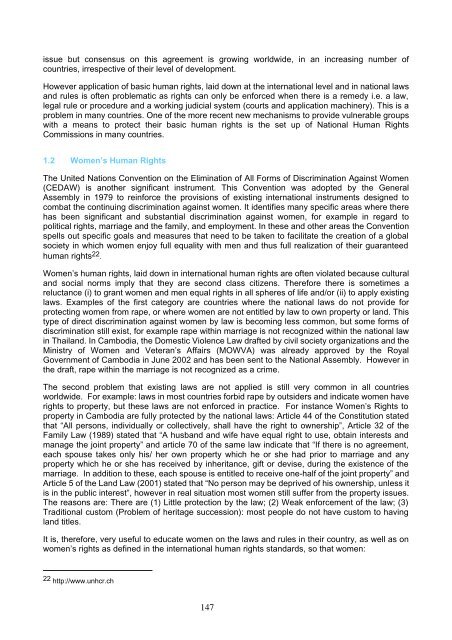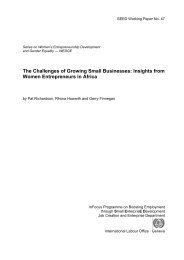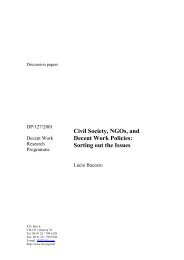manual: women workers' rights and gender equality - International ...
manual: women workers' rights and gender equality - International ...
manual: women workers' rights and gender equality - International ...
Create successful ePaper yourself
Turn your PDF publications into a flip-book with our unique Google optimized e-Paper software.
issue but consensus on this agreement is growing worldwide, in an increasing number of<br />
countries, irrespective of their level of development.<br />
However application of basic human <strong>rights</strong>, laid down at the international level <strong>and</strong> in national laws<br />
<strong>and</strong> rules is often problematic as <strong>rights</strong> can only be enforced when there is a remedy i.e. a law,<br />
legal rule or procedure <strong>and</strong> a working judicial system (courts <strong>and</strong> application machinery). This is a<br />
problem in many countries. One of the more recent new mechanisms to provide vulnerable groups<br />
with a means to protect their basic human <strong>rights</strong> is the set up of National Human Rights<br />
Commissions in many countries.<br />
1.2 Women’s Human Rights<br />
The United Nations Convention on the Elimination of All Forms of Discrimination Against Women<br />
(CEDAW) is another significant instrument. This Convention was adopted by the General<br />
Assembly in 1979 to reinforce the provisions of existing international instruments designed to<br />
combat the continuing discrimination against <strong>women</strong>. It identifies many specific areas where there<br />
has been significant <strong>and</strong> substantial discrimination against <strong>women</strong>, for example in regard to<br />
political <strong>rights</strong>, marriage <strong>and</strong> the family, <strong>and</strong> employment. In these <strong>and</strong> other areas the Convention<br />
spells out specific goals <strong>and</strong> measures that need to be taken to facilitate the creation of a global<br />
society in which <strong>women</strong> enjoy full <strong>equality</strong> with men <strong>and</strong> thus full realization of their guaranteed<br />
human <strong>rights</strong> 22 .<br />
Women’s human <strong>rights</strong>, laid down in international human <strong>rights</strong> are often violated because cultural<br />
<strong>and</strong> social norms imply that they are second class citizens. Therefore there is sometimes a<br />
reluctance (i) to grant <strong>women</strong> <strong>and</strong> men equal <strong>rights</strong> in all spheres of life <strong>and</strong>/or (ii) to apply existing<br />
laws. Examples of the first category are countries where the national laws do not provide for<br />
protecting <strong>women</strong> from rape, or where <strong>women</strong> are not entitled by law to own property or l<strong>and</strong>. This<br />
type of direct discrimination against <strong>women</strong> by law is becoming less common, but some forms of<br />
discrimination still exist, for example rape within marriage is not recognized within the national law<br />
in Thail<strong>and</strong>. In Cambodia, the Domestic Violence Law drafted by civil society organizations <strong>and</strong> the<br />
Ministry of Women <strong>and</strong> Veteran’s Affairs (MOWVA) was already approved by the Royal<br />
Government of Cambodia in June 2002 <strong>and</strong> has been sent to the National Assembly. However in<br />
the draft, rape within the marriage is not recognized as a crime.<br />
The second problem that existing laws are not applied is still very common in all countries<br />
worldwide. For example: laws in most countries forbid rape by outsiders <strong>and</strong> indicate <strong>women</strong> have<br />
<strong>rights</strong> to property, but these laws are not enforced in practice. For instance Women’s Rights to<br />
property in Cambodia are fully protected by the national laws: Article 44 of the Constitution stated<br />
that “All persons, individually or collectively, shall have the right to ownership”, Article 32 of the<br />
Family Law (1989) stated that “A husb<strong>and</strong> <strong>and</strong> wife have equal right to use, obtain interests <strong>and</strong><br />
manage the joint property” <strong>and</strong> article 70 of the same law indicate that “If there is no agreement,<br />
each spouse takes only his/ her own property which he or she had prior to marriage <strong>and</strong> any<br />
property which he or she has received by inheritance, gift or devise, during the existence of the<br />
marriage. In addition to these, each spouse is entitled to receive one-half of the joint property” <strong>and</strong><br />
Article 5 of the L<strong>and</strong> Law (2001) stated that “No person may be deprived of his ownership, unless it<br />
is in the public interest”, however in real situation most <strong>women</strong> still suffer from the property issues.<br />
The reasons are: There are (1) Little protection by the law; (2) Weak enforcement of the law; (3)<br />
Traditional custom (Problem of heritage succession): most people do not have custom to having<br />
l<strong>and</strong> titles.<br />
It is, therefore, very useful to educate <strong>women</strong> on the laws <strong>and</strong> rules in their country, as well as on<br />
<strong>women</strong>’s <strong>rights</strong> as defined in the international human <strong>rights</strong> st<strong>and</strong>ards, so that <strong>women</strong>:<br />
22 http://www.unhcr.ch<br />
147

















